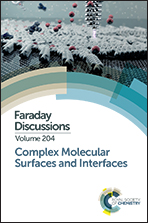Molecular self-assembly of substituted terephthalic acids at the liquid/solid interface: investigating the effect of solvent†
Abstract
Self-assembly of three related molecules – terephthalic acid and its hydroxylated analogues – at liquid/solid interfaces (graphite/heptanoic acid and graphite/1-phenyloctane) has been studied using a combination of scanning tunnelling microscopy and molecular mechanics and molecular dynamics calculations. Brickwork-like patterns typical for terephthalic acid self-assembly have been observed for all three molecules. However, several differences became apparent: (i) formation or lack of adsorbed monolayers (self-assembled monolayers formed in all systems, with one notable exception of terephthalic acid at the graphite/1-phenyloctane interface where no adsorption was observed), (ii) the size of adsorbate islands (large islands at the interface with heptanoic acid and smaller ones at the interface with 1-phenyloctane), and (iii) polymorphism of the hydroxylated terephthalic acids’ monolayers, dependent on the molecular structure and/or solvent. To rationalise this behaviour, molecular mechanics and molecular dynamics calculations have been performed, to analyse the three key aspects of the energetics of self-assembly: intermolecular, substrate–adsorbate and solvent–solute interactions. These energetic characteristics of self-assembly were brought together in a Born–Haber cycle, to obtain the overall energy effects of formation of self-assembled monolayers at these liquid/solid interfaces.
- This article is part of the themed collection: Complex Molecular Surfaces and Interfaces


 Please wait while we load your content...
Please wait while we load your content...